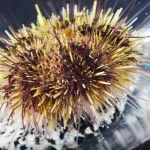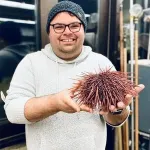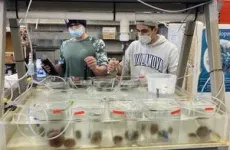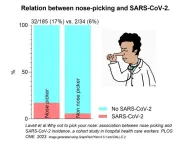(Press-News.org) When driving through a rainstorm, traction is key. If your tires lack sufficient tread, your vehicle will slip and slide and you won’t have the grip needed to maneuver safely. When torrential rains hit nearshore, shallow water ecosystems, sea urchins experience a similar challenge. Heavy precipitation can alter the concentration of salt in the ocean waters causing lower salinity levels. Even a slight change in salinity can affect the ability of sea urchins to securely attach their tube feet to their surroundings – like tires gripping the road. This becomes a matter of life and death for the small spiny creatures, as they rely on their adhesive structures to move in the wave-battered rocky area near the seashore.
Syracuse University biologists co-authored a study exploring how sea urchin adhesive abilities are affected by differing levels of water salinity.
The survival of sea urchins is vital for maintaining balance within marine ecosystems. Sea urchins are responsible for grazing around 45% of algae on coral reefs. Without sea urchins, coral reefs can become overgrown with macroalgae, which can limit the growth of corals. With the importance of coral reefs for coastal protection and preservation of biodiversity, it is critical to safeguard the sea urchin population.
As global climate change causes weather extremes ranging from heat waves and droughts to heavy rains and flooding, the large amounts of freshwater pouring into nearshore ecosystems are altering habitats. A team of biologists, led by Austin Garner, assistant professor in the College of Arts and Sciences’ Department of Biology, studied the impacts of low salinity and how it alters sea urchins’ ability to grip and move within their habitat. Garner, who is a member of Syracuse University’s BioInspired Institute, studies how animals attach to surfaces in variable environments from the perspective of both the life and physical sciences.
The team’s study, recently published in the Journal of Experimental Biology, sought to understand how sea urchin populations will be affected by future extreme climatic events.
“While many marine animals can regulate the amount of water and salts in their bodies, sea urchins are not as effective at this,” says Garner. “As a result, they tend to be restricted to a narrow range of salinity levels. Torrential precipitation can cause massive amounts of freshwater to be dumped into the ocean along the coastline causing rapid reductions in the concentration of salt in seawater.”
The group’s research was conducted at the University of Washington’s Friday Harbor Laboratories (FHL). The study’s lead author, Andrew Moura, who is a graduate student in Garner’s lab at Syracuse, traveled to FHL along with Garner and researchers from Villanova University to conduct experiments with live green sea urchins. They worked alongside former FHL postdoctoral scholar Carla Narvaez, who is now an assistant professor of biology at Rhode Island College, and Villanova University professors Alyssa Stark and Michael Russell.
At FHL, the researchers separated sea urchins into 10 groups based on differing salinity levels within each tank, from normal to very low salt content. Among each group, they tested metrics including righting response (the ability for sea urchins to flip themselves over), locomotion (speed from one point to another) and adhesion (force at which their tube feet detach from a surface). In Garner’s lab at Syracuse, he and Moura completed data analysis to compare each metric.
The team found that sea urchin righting response, movement, and adhesive ability were all negatively impacted by low salinity conditions. Interestingly, though, sea urchin adhesive ability was not severely impacted until very low salinity levels, indicating that sea urchins may be able to remain attached in challenging nearshore environmental conditions even though activities that require greater coordination of tube feet (righting and movement) may not be possible.
“When we see this decrease in performance under very low salinity, we might start seeing shifts in where sea urchins might be living as a consequence of their inability to remain stuck in certain areas that experience low salinity,” explains Moura. “That could change how much sea urchin grazing is happening and could have profound ecosystem effects.”
Their work provides critical data that enhances researchers’ ability to predict how important animals like sea urchins will fare in a changing world. The adhesion principles Garner and his team are exploring could also come in handy for human-designed adhesive materials – work that aligns with the Syracuse University BioInspired Institute’s mission of addressing global challenges through innovative research.
“If we can learn the fundamental principles and molecular mechanisms that allow sea urchins to secrete a permanent adhesive and use it for temporary attachment, we could harness that power into the design challenges or our adhesives today,” says Garner. “Imagine being able to have an adhesive that is otherwise permanent, but then you add another component, and it breaks it down and you can go stick it again somewhere else. It’s a perfect example of how biology can be used to enhance the everyday products around us.”
END
Sea urchins are struggling to ‘get a grip’ as climate change alters ecosystems
Syracuse University researchers explore how excess freshwater from climate change-associated events such as increased torrential rainstorms are impacting sea urchin survival
2023-08-02
ELSE PRESS RELEASES FROM THIS DATE:
When D turns to F, quantum matter is A-plus
2023-08-02
HOUSTON – (Aug. 2, 2023) – Rice University physicists have shown that immutable topological states, which are highly sought for quantum computing, can be entangled with other, manipulable quantum states in some materials.
“The surprising thing we found is that in a particular kind of crystal lattice, where electrons become stuck, the strongly coupled behavior of electrons in d atomic orbitals actually act like the f orbital systems of some heavy fermions,” said Qimiao Si, co-author of a study about the research in Science Advances.
The unexpected find provides ...
A novel strategy to suppress triple negative breast cancer growth
2023-08-02
In 2022, a team of researchers at Baylor College of Medicine discovered that a little-known enzyme called MAPK4 is involved in the growth of triple negative breast cancer (TNBC) and its resistance to certain therapies. Looking into the details of this novel role of MAPK4, the researchers have now identified a strategy that can potentially control MAPK4-promoted growth in TNBC and other cancers. The study, published in PLOS Biology, opens new options for treating this devastating disease.
“Some cancers depend on MAPK4 for their growth, and our team studies cellular processes or pathways that participate in ...
Super Radar: Breakthrough radar research overcomes a nearly century-old trade-off between wavelength and distance resolution
2023-08-02
New interference radar functions employed by a team of researchers from Chapman University and other institutions improve the distance resolution between objects using radar waves. The results may have important ramifications in military, construction, archaeology, mineralogy and many other domains of radar applications.
This first proof-of-principle experiment opens a new area of research with many possible applications that can be disruptive to the multi-billion dollar radar industry. There are many new avenues to pursue both in theory and experiment.
The ...
Study finds Black people less likely to be seen at memory clinic than white people
2023-08-02
MINNEAPOLIS – Black people and people living in less affluent neighborhoods—areas with higher poverty levels and fewer educational and employment opportunities— may be less likely to be seen at a memory care clinic compared to white people and people living in neighborhoods with fewer disadvantages, according to new research published in the August 2, 2023, online issue of Neurology®, the medical journal of the American Academy of Neurology.
“Our results are concerning, especially ...
Bullying, suicidal thoughts linked to more frequent headaches in teens
2023-08-02
MINNEAPOLIS – Teens who have been bullied by their peers, or who have considered or attempted suicide, may be more likely to have more frequent headaches than teens who have not experienced any of these problems, according to a study published in the August 2, 2023, online issue of Neurology®, the medical journal of the American Academy of Neurology. The study does not prove that bullying or thoughts of suicide cause headaches; it only shows an association.
“Headaches are a common problem for teenagers, but our study looked beyond the biological factors to also consider the psychological and social factors that are associated with headaches,” ...
Study defines disparities in memory care
2023-08-02
Patients who live in less affluent neighborhoods and those from underrepresented racial or ethnic groups are less likely than others to receive specialized care for dementia, including Alzheimer’s disease, a new study from Washington University School of Medicine in St. Louis indicates. Further, the research shows that Black people are more likely than white people to be diagnosed with dementia at a later, more advanced stage, which could contribute to inequities in access to new treatments.
The study appears Aug. 2 in the journal Neurology.
New medications ...
New analysis shows surgery is safe and effective for people with unruptured brain arteriovenous malformation
2023-08-02
CONTACT: Camille Jewell
cjewell@vancomm.com or 202-248-5460
SAN DIEGO—Contrary to the results of a seminal study in the field, a recent analysis presented today at the Society of NeuroInterventional Surgery’s (SNIS) 20th Annual Meeting indicates that surgical approaches (embolization, microsurgery, radiosurgery) for treating selected patients with unruptured arteriovenous malformation (AVM) is safe and effective.
AVMs are tangled blood vessels with abnormal connection between arteries and veins, bypassing the capillary ...
Researchers develop smartphone app that reliably recognizes physical signs of stroke
2023-08-02
CONTACT: Camille Jewell
cjewell@vancomm.com or 202-248-5460
SAN DIEGO—Today at the Society of NeuroInterventional Surgery’s (SNIS) 20th Annual Meeting, researchers discussed a smartphone app created that reliably recognizes patients’ physical signs of stroke with the power of machine learning.
In the study, “Smartphone-Enabled Machine Learning Algorithms for Autonomous Stroke Detection,” researchers from the UCLA David Geffen School of Medicine and multiple medical institutions in Bulgaria used data from 240 patients with stroke at four metropolitan stroke centers. Within 72 hours of the ...
Nose-picking healthcare workers were more likely to catch COVID-19 during the pandemic than their colleagues who refrained, per Netherlands cohort study
2023-08-02
Nose-picking healthcare workers were more likely to catch COVID-19 during the pandemic than their colleagues who refrained, per Netherlands cohort study
###
Article URL: https://journals.plos.org/plosone/article?id=10.1371/journal.pone.0288352
Article Title: Why not to pick your nose: Association between nose picking and SARS-CoV-2 incidence, a cohort study in hospital health care workers
Author Countries: The Netherlands
Funding: This work was funded by the Netherlands Organization for Health Research and Development ZonMw (S3 study, grant agreement no. 10430022010023 to M.K.B.) and the Corona ...
Half of popular TikTok videos about Baby Boomers portray older adults negatively, risking reinforcing stereotypes and creating intergenerational conflict
2023-08-02
Half of popular TikTok videos about Baby Boomers portray older adults negatively, risking reinforcing stereotypes and creating intergenerational conflict
###
Article URL: https://journals.plos.org/plosone/article?id=10.1371/journal.pone.0285987
Article Title: Videos about older adults on TikTok
Author Countries: Singapore
Funding: We gratefully acknowledge the support of the Social Science Research Council SSHR Fellowship (MOE2018-SSHR-004). The funders had no role in study design, data collection and analysis, decision to ...
LAST 30 PRESS RELEASES:
The Ceramic Society of Japan’s Oxoate Ceramics Research Association launches new international book project
Heart-brain connection: international study reveals the role of the vagus nerve in keeping the heart young
Researchers identify Rb1 as a predictive biomarker for a new therapeutic strategy in some breast cancers
Survey reveals ethical gaps slowing AI adoption in pediatric surgery
Stimulant ADHD medications work differently than thought
AI overestimates how smart people are, according to HSE economists
HSE researchers create genome-wide map of quadruplexes
Scientists boost cell "powerhouses" to burn more calories
Automatic label checking: The missing step in making reliable medical AI
Low daily alcohol intake linked to 50% heightened mouth cancer risk in India
American Meteorological Society announces Rick Spinrad as 2026 President-Elect
Biomass-based carbon capture spotlighted in newly released global climate webinar recording
Illuminating invisible nano pollutants: advanced bioimaging tracks the full journey of emerging nanoscale contaminants in living systems
How does age affect recovery from spinal cord injury?
Novel AI tool offers prognosis for patients with head and neck cancer
Fathers’ microplastic exposure tied to their children’s metabolic problems
Research validates laboratory model for studying high-grade serous ovarian cancer
SIR 2026 delivers transformative breakthroughs in minimally invasive medicine to improve patient care
Stem Cell Reports most downloaded papers of 2025 highlight the breadth and impact of stem cell research
Oxford-led study estimates NHS spends around 3% of its primary and secondary care budget on the health impacts of heat and cold in England
A researcher’s long quest leads to a smart composite breakthrough
Urban wild bees act as “microbial sensors” of city health.
New study finds where you live affects recovery after a hip fracture
Forecasting the impact of fully automated vehicle adoption on US road traffic injuries
Alcohol-related hospitalizations from 2016 to 2022
Semaglutide and hospitalizations in patients with obesity and established cardiovascular disease
Researchers ‘listen in’ to embryo-mother interactions during implantation using a culture system replicating the womb lining
How changing your diet could help save the world
How to make AI truly scalable and reliable for real-time traffic assignment?
Beyond fragmented markets: A new framework for efficient and stable ride-pooling
[Press-News.org] Sea urchins are struggling to ‘get a grip’ as climate change alters ecosystemsSyracuse University researchers explore how excess freshwater from climate change-associated events such as increased torrential rainstorms are impacting sea urchin survival





